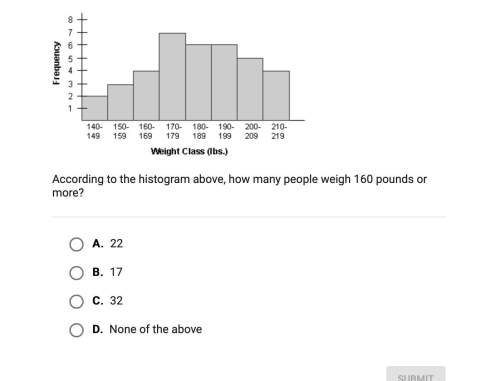
Mathematics, 15.07.2019 06:00 hannah1571
Solve (x + 9)² = 25. 1. apply the square root property of equality. 2. isolate the variable.

Answers: 1


Another question on Mathematics

Mathematics, 21.06.2019 14:30
Acommunity group sells 2,000 tickets for its raffle. the grand prize is a car. neil and 9 of his friends buy 10 tickets each. when the winning ticket number is announced, it is found to belong to neil's group. given this information, what is the probability that the ticket belongs to neil? a.1/5 b.1/10 c.1/200 d.1/4
Answers: 2

Mathematics, 21.06.2019 14:30
Our goal is to collect email addresses from 60% of customers who purchase a product." so that means if i talk to 95 customers, i need to persuade to provide an email address?
Answers: 1

Mathematics, 21.06.2019 15:30
Michelle had a birthday party. she bought a bag of candy with 96 starbursts, 72 hershey's, and 68 reese's. she wants to use all the candy she bought to make goody bags with the same amount of starbursts, hershey's and reese's in each bag. what is the largest number of bags she can make?
Answers: 1

Mathematics, 21.06.2019 17:00
In tossing one coin 10 times, what are your chances for tossing a head? a tail? 2. in tossing one coin 100 times, what are your chances for tossing a head? a tail? 3. in tossing one coin 200 times, what are your chances for tossing a head? a tail? deviation = ((absolute value of the difference between expected heads and observed heads) + (absolute value of the difference between expected tails and observed tails)) divided by total number of tosses. this value should always be positive. 4. what is the deviation for 10 tosses? 5. what is the deviation for the 100 tosses? 6. what is the deviation for 200 tosses? 7. how does increasing the total number of coin tosses from 10 to 100 affect the deviation? 8. how does increasing the total number of tosses from 100 to 200 affect the deviation? 9. what two important probability principles were established in this exercise? 10. the percent of occurrence is the obtained results divided by the total tosses and multiplied by 100%. toss the coins 100 times and record your results. calculate the percent occurrence for each combination. percent head-head occurrence: percent tail-tail occurrence: percent head-tail occurrence:
Answers: 3
You know the right answer?
Solve (x + 9)² = 25. 1. apply the square root property of equality. 2. isolate the variable....
Questions



Mathematics, 30.01.2021 14:00


Mathematics, 30.01.2021 14:00

Mathematics, 30.01.2021 14:00


Business, 30.01.2021 14:00

Biology, 30.01.2021 14:00

Mathematics, 30.01.2021 14:00



Mathematics, 30.01.2021 14:00

Mathematics, 30.01.2021 14:00

Medicine, 30.01.2021 14:00

Mathematics, 30.01.2021 14:00


Physics, 30.01.2021 14:00

English, 30.01.2021 14:00





